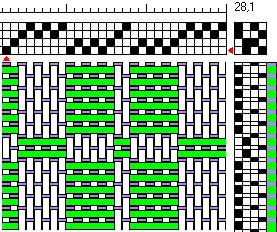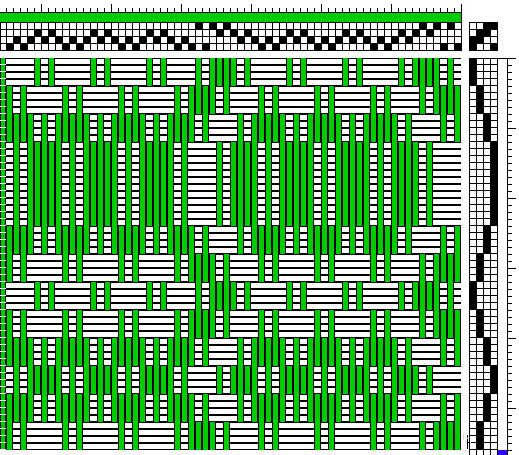Some thoughts about "overshot"
To "shoot over" – to me, that suggests that the weft floats over some kind of base cloth.
However, the weft can't just "float", it has to be anchored in some way.
Bergdala Spinnhus |
|
- About 4-shaft counterbalance looms (Scandinavian style) - About multi-shaft (dräll pulley) CB looms - About jämtlandsdräll - Thoughts about "overshot" - Some rag weave facts - Om vadmal - Om färgeffekt - About fabric analyis - bindningskonstruktion (opens in new window) - About construction of double layers - About weaving double width - Double width, part 2 - About profile patterns - How to expand a profile pattern - More about profile patterns - Om tagelvävning - About differential shrinkage - Solid colour? - Om datoriserad vävstol - About old wooden reeds - About reading old literature - About Hulda Peters vävbok - threading notations, part 1 - threading notations, part 2 - About horsehair - Tageltyg från Småland - ideas about displaying - "Original", kopia eller plagiat? - A survey of Swedish weaving books - Om tyst kunskap - Nog nu! in English: - Serial weaving - "TWILL" - Block substitution - Vadmal |
|
Some thoughts about "overshot"
To "shoot over" – to me, that suggests that the weft floats over some kind of base cloth.
|
||||||||||
|
So, what if it floats sometimes over, sometimes under that "base cloth"?
And what if the "base cloth" is plain weave, woven simultaneously with the over-or-under-floating weft? - I think we have just invented what often is called "monk's belt"... If the pattern weft is to float either over, either under (like monk's belt) we can get two blocks on four shafts – no more, no less. |

|
|||||||||||
|
What if we want to have bigger (no, MUCH bigger) blocks of the weft floating over?
Well, either we get a very impractical result – loose wefts (say) four inches long will get tangled and pulled by just about any usage – or we have to do something to anchor the weft her and there along the four inches. One way to fix that is to periodically change one warp end from its "proper" shaft, instead threading it on another, from the other block. And, guess what: we have invented something often called (in Swedish) halv-dräll... (Read more on my blog, here (opens in new window)) |

|
|||||||||||
|
Both these methods can only give two blocks on four shafts. The plain weave "base cloth"
(often called ground cloth) is true all over: only the warp and the plain weave weft intersect at all times.
The pattern is likewise "undiluted", floating either over or under. But what if we want more blocks, but still only have four shafts? Hm. Is there a way to let blocks share shafts, maybe? Yes, there is – but one inevitable result is that the pattern weft sometimes must be "hidden" (share a shed with the tabby weft), which we accept and even give a name: "half-tone" area. There are several "methods", "threading systems", to do this, but what they have to have in common is to be able to produce true tabby. The most common four-blocks-on-four-shafts weave in Sweden is what we call "daldräll". Our approach to fixing the true tabby is to define the blocks according to "the odd-even rule", that is, if threading the blocks "as is", every other end is placed on an odd-numbered shaft, the other ends on an even-numbered shaft. Thus, the four daldräll blocks become: |
||||||||||||
| ||||||||||||
|
Here is a small profile draft (in blue and white, because that is how we write profile drafts in Sweden). The blocks are numbered according to Swedish tradition, from back to front. (Find out more about profile patterns and how to expand them in the left-side menu) 
To the right, the detail threading (in red and white, the Swedish way)
(For weaving, tabby must be added - more about that later) |

|
|||||||||||
|
Some observations: all blocks have all four ends; the "odd-even rule" is preserved without the need for
"fixing" (adding incidentals and/or subtracting ends).
Counting the lengths of the pattern floats, it can be seen that they vary from 4 to 6; most of them are five ends long. Where one block has a six-end float, the corresponding block on the other side of the "figure" has a four-end float. So, does this method differ from the American "overshot"? While admitting I have not read much about the theory of the american overshot, I trust my software (I use Fiberworks) to know what is regarded as "standard". |
||||||||||||
|
The "standard" Fiberworks method ("common threads" and "balanced" checked) have
eliminated some ends."Balanced" means that each block has a reversed threading direction on the other side
of the motif.
While the Swedish method yielded 72 ends for the profile, the American gave 65. Counting the lengths of the pattern floats, it can be seen that they vary between 4 and 5; most of them are five ends long. The "balancing" has brought the "Swedish" six-end blcoks down to four-end ones. I had to shift the tie-up one step to preserve the treadling order. (Alternatively, if keeping both the tieup and the treadling order, the motif would have been shifted one block along the warp.) (And I made it green-and-white not to confuse it with the Swedish style detail threading...) |

|
|||||||||||

|
Me (the lazy Swede) find it difficult to "read" the overshot threading - but that might be because I never
even try to thread daldräll from a detail threading: I know how to thread each block, so I can thread directly
from the profile...
Here I have tried to colour-code the blocks, to try to see what the differences are, and where/which ends are taken out. |
|||||||||||
|
Now for the next part: the tabbies.
Tabby, you say - but that is just the plain weave picks between the pattern picks? Yes, but when adding the tabby picks, it can be important to choose the "right" sequence – "right" is a personal preference – because for the even-numbered floats (4 or 6 long), the pattern picks become paired in one end, divided in the other end. The odd-numbered floats (5 long) they can either be paired in both ends, or divided in both ends. Like so: |
||||||||||||

|
The black rectangles show the five-long pattern floats. It can be seen that the floats become either paired or
divided. They are "the same" on both ends of a float area.
The red rectangles show the four-long pattern floats. It can be seen that they are paired in one end, divided in the other.
The reason for this phenomenon is that a tabby repeat comprises two ends (coloured here: one blue, one purple warp end to a repeat) – a float over four ends means that it contains two tabby repeats, while a float over five ends goes over two-and-a-half repeats. |
|||||||||||
|
|
||||||||||||

|
But (there is always a but...) the front and the back will always be their opposites, not only in what the pattern
looks like.
The pairings/divisions will be opposite, too. If, on the front side, there are "divisions" for the five-long floats, there will be "pairings" on the back. (Not in the same place, of course – if there are floats on the right side, there is pure tabby on the back. Only the half-tone areas show on both sides.) The way to get, say, divisions on both sides is to add (or eliminate) a tabby pick (or a pattern pick) between the blocks (which in fact is the same as "shifting" the tabbies as of above). 
|
|||||||||||
|
This pairing/division of the pattern picks are inherent to all structures using a tabby ground. Sometimes they will
be very obvious, sometimes not - depending on things like the fineness of the threads used, colour contrasts, the
complexity of the pattern.
Examine a "summer & winter" piece and it will be there, too - or look at the monk's belt in the beginning of this article, or at the halv-dräll following it... | ||||||||||||